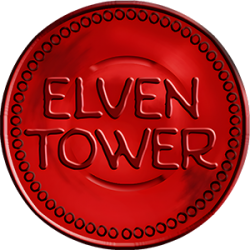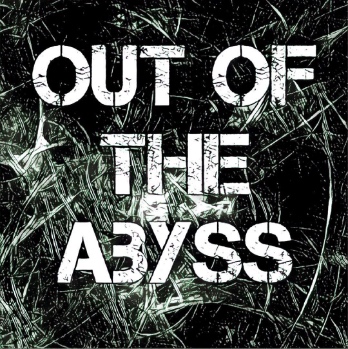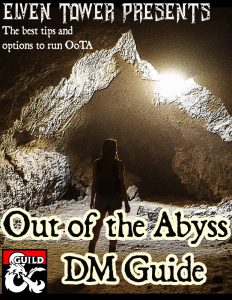The GUIDE index is here !
Chapter 9 in the book is actually Mantol Derith, but you have to travel through the underdark to get there so it makes sense that this chapters goes first in my guide. This is an update of Chapter 2 – The Darklake, it’s about traversing the underdark and going from place to place, what’s different? The PC’s now have an expeditionary force of probably 25+ people, the pace and feeling are different, there are new encounters and social encounters too.
You have to get ready for this part of the adventure because right after Gauntlgrym, the Zentharim agents will have the PC’s travel 180 miles on the surface (8 days at normal pace) and then 200 miles in the underdark (that’s 33 days of travel at normal pace), that’s plenty of time an opportunities for the party to use their new abilities and influence with their NPC companions.
Descent into the Depths index:
- Leveling and Campaign Structure
- The expeditionary force
- Traveling and Encounters
- Building outposts
- Visiting old places
Leveling and campaign structure
Some details about the adventure and advancement are left too vague in the book. After Gauntlgrym, the adventure is quite linear, and everything is geared toward the climatic battle in Menzoberranzan, but according to the book, the adventurers visit the drow city in chapter 15, then travel to Araumycos in chapter 16 and then back to Menzoberranzan for the ending. It doesn’t make much sense story wise. It ruins the build up, my suggestion is to run The Fetid Wedding before Menzoberranzan. It works very well and makes the story flow better. The other thing that is never addressed after Gauntlgrym is leveling. We know PC’s are supposed to be level 8 in Gauntlgrym and 15 at the end of the adventure but there is nothing else to go with. This is my suggestion for leveling and order of events for the second part of the adventure.
- Gauntlgrym – Level 8
- Mantol Derith – Level 9 after finishing it.
- Gravenhollow
- Tower of Vengeance
- Wormwrithings – Level 10 after the Worm Nursery – Level 11 after the Vast Oblivion.
- Labyrinth – Level 12 either after defeating Yeenoghu or using the Maze engine.
- The Fetid Wedding – Level 13 after battling Zuggtmoy and Juiblex.
- The City of Spiders – Level 14 after setting the dark heart.
- Final battle
This progression gets the PC’s to level up to 15 after the final battle. A party of 4 or more level 14 characters is a very dangerous threat, even for the likes of Orcus or Demogorgon. There is no need for the PC’s to be lv15 before the final battle. A well balanced party of level 11 has good probabilities of defeating Yeenoghu in the Labyrinth. At level 13, they can fight with Zuggtmoy in the grey dream, and after, fight and even defeat Juiblex. It’s hard but possible, and it gives PC’s a feeling of self-fulfillment and epicness.
It is daunting and somewhat scary when you read how many people will follow the PC’s back into the underdark. If the party was smart and forged an alliance with all of the factions back at Gauntlgrym, they have:
- 1 Shield Guardian (I recommend to nerf it to 100HP)
- 7 giant lizards (assuming 4 PC’s)
- 5 veterans
- 3 scouts
- 3 spies
- 5 guards
- 8 thugs
Plus any NPC that is still with the party, like Derendil or Eldeth. Assuming 4 PC’s, the total is 30 people, 1 shield guardian and the lizards. It’s crazy ! You may even have some flashbacks of the first session back in Velkynvelve, breaking out of prison at level 1 with 10 player-controlled NPC’s, some of them completely useless like Stool or Shuushar. Those were the good old days.
It’s actually very different now and there is no reason to panic. The objective of the expeditionary force is not a combat-wise advantage, or a mass combat dynamic. It’s really more of a flavor feel. Months back when the characters were traversing the underdark looking for a way out, they were miserable. They were unprepared, unarmed, they didn’t have food and had to make do with anything they found just to see the next day. But now, they are the bosses, now they are important, their importance recognized by King Bruenor and the other factions representatives. The expeditionary force is there to make the PC’s lives easier. So, how does it work now?
When traveling, you are supposed to explain that as important as they are, a lot of the activities they were used to do when traveling are now delegated to other people. First thing the PC’s have to do is to assign a lieutenant, a person in charge, one of the veterans from the Order of the Gauntlet is a great choice. Additionally, they may want to assign a master-explorer or a camp-leader. Think of the expeditionary force like a bubble structure, you can use a three layered structure of responsibilities with well-defined roles:

- The inner Circle.- Here are the highest status people, this includes the PC’s, any assigned lieutenant and maybe a Zentharim thug representing his faction. This people make all the decisions regarding the expeditionary force as a whole. PC’s have the last word, but may consult the other leaders for their opinions.
- The Main Force.- This is the bulk of the group, most people fall in this area. The force’s lieutenant leads them and delegates the different activities to be done, such as foraging, cooking, repairing stuff, fight threats that the scouting party finds, setting up camp.
- Scouting party.- The scouts don’t travel with the expeditionary force, these brave people often travel a few kilometers ahead and behind the main force. Every hour one of them is sent back to give report to the Force’s lieutenant, he can then make decisions. If the scouts spot a threat they are supposed to get as much intel as they can and then go back and report to the the lieutenant, they don’t fight before informing.
In an organization such as this one, the PC’s travel and have everything done for them. After the past few months of traversing the underdark like poor pariahs, it is a welcome change. The underdark is dangerous, but with such a big group, most threats won’t likely attack openly. Even then, everyday or two, the main force has to fight something, being a goblin party, an orc ambush, or other underdark denizens. They are mostly capable of handling what they find. At the end of the day the lieutenant might tell the PC’s that the main force fought and defeated some carrion crawlers. In any of these encounters handled by the main force I recommend rolling a percentile check, any result above 50 means that there are 1d6 people hurt and being tended by combat medics. Above 85 means that 1 person died and 1d6 are hurt.
The members of the expeditionary force know about the PC’s prowess in combat but will not bother them with threats that they deem small. Every few days, the main force or scouting party might run into something that is out of their possibilities to handle it. This is a PC’s encounter. There are three ways to start this:
- The scouting party spots a threat and reports back to the lieutenant. He decides it’s better to inform his superiors (the PC’s), the PC’s can then go to the front line and face the enemies. There should be an instruction that when the scouts spot demonic activity, this always goes all the way back to the PC’s, the main force never fights demons by itself.
- The scouting party spots a threat and reports back to the lieutenant. He decides to take on the enemies with the main force. Mid fight, the enemies get reinforcements or just prove to be too powerful for them. He sends an urgent messenger back to the inner circle to inform the PC’s of the ongoing fight. When the PC’s rush to the front line, they find the tough fighters like the veterans and thugs holding the enemies at bay, waiting to be relieved. Some men might already have fallen or be on the floor, hurt.
- The scouting party misses a threat and the main force is taken by surprise. Regardless of the threat level, an urgent messenger is sent to inform the PC’s, they might arrive to save the main force, or arrive to see the main force get rid of a small threat.
This gives importance to the PC’s, they are only bothered with the dangerous fights which I recommend to have every 3 or 4 days. It would be a nightmare to handle a fight with all 25+ members of the expeditionary force. An easy way of going over this problem is that when the PC’s are fighting, the expeditionary force stands back offering cover fire. Assign initiative count zero for the main force cover-fire archers and crossbow men. To save time, just assume a damage number, to be dealt to the enemies. For example 15-20 damage, you can divide it among different enemy creatures, describing how the main force is attacking anything they can see. Halve the number for enemies with damage resistances like most demons. This damage figure can change according to several things, like enemy armor (the lower the AC the more damage and viceversa), damage resistances, the number of people available from the expeditionary force. Doing this you will keep the fights fluid, and the main force engaged in helping the PC’s at the same time.
The book suggests the encounter tables from chapter 2 for random encounters, this are great for the main force to take on, but severely underpowered to endanger the PC’s. Sadly the only encounters that are worth of the PC’s attention are the demon encounters (page 146). I highly advice DM’s to prepare some extra encounters that are more level-appropriate. Some ideas are, strong drow party, orc ambush with traps, a buffed rocktopus, different demon encounters, driders, grick pack, gnoll ambush, etc.
On page 145 there are tables from random stuff encounters for the adventuring party, they range from disease, poisoned friends, problems with discipline, people going crazy, and vanishing NPC’s among other options. These are great to spice the days without fights, and are great opportunities for using PC’s abilities that are sometimes not so used, for example if they have a problem with spoiled supplies, a cleric can use purify food. Same with NPC’s falling sick, a paladin can use his Lay on hands ability to heal them. Others are great for roleplaying, like the discipline problems which will strain the PC’s abilities to handle such social situations. Or an NPC mysteriously vanishing, probably forcing the expeditionary force to stop moving and assigning searching parties, darkening everyone’s mood.
In this campaign there is A LOT of traveling by land involved. Ehen the PC’s reach level 9 they will have access to teleportation spells. Except that there is a fail-safe, the faerzress will render almost all teleportation useless. This is done to have characters travel a lot, but when you see the numbers, it really is a lot of traveling. I actually recommend allowing teleportation without all this hassle, but only for going back to places you already have visited. I see no problem in giving them the possibility to teleport back to Gauntlgrym to report things to the king or get some supplies, bringing back severely hurt allies and the like. They still have to travel by land when visiting new places. If the PC’s party classes don’t give them access to teleportation spells, I recommend placing a teleporting helmet in Mantol Derith, in Ghazrim DuLoc’s warehouse shed (number 9, page 141).
This is a great mechanic explained in page 147, it’s a great way to reduce the size of the expeditionary force by having them build an outpost (fortified camp), a defensible place. Its objective is to provide PC’s a place to go back to in time of need. It can take the form of a barricaded cave, a small walled compound, a darklake island camp, a hard to reach ledge or any other easily defendible place. If there is a cleric, he can cast hallow to provide more protections against fiends and undead. He could also cast Word of Recall to make this a teleportation location.
Awesome places to build outposts are, Mantol Derith, it can be left as a police force to keep things cool in Mantol Derith. Outside Gravenhollow, for easy going back to the library for whatever reason. Close to Araumycos for an easy way out. The outpost building is awesome because it gives the players sense of accomplishment, they are building new places and making the world a better place. The expeditionary force will reduce its numbers very fast if they build some of these outposts. There is an opportunity of gaining a big number of followers in the Vast Oblivion (page 175). After defeating Karazikar, the party can get 100 followers. That’s great for building more outposts or even making an existing outpost bigger, maybe even convert it in a would-be town.
On page 147 there’s some info of things as they are at this point in time in places the PC’s visited before. Although some of the info is great, I found that it could be rendered useless, depending on what the PC’s did when they where there in the first place. The DM has to assess what were the PC’s actions consequences after visiting said places, and make some decisions about what’s up in that place several months after, when they visit it again. For example, if the PC’s helped the Diggermattocks in Blingdenstone get rid of the ooze invasion, he may reinforce their expeditionary force with some deep gnomes (page 147). But if the PC’s ignored this quest or ended in bad terms with the gnomes, then this doesn’t happen, and they won’t help them. Gracklstugh is an oddball too, as things might have gone many different ways when the PC’s visited the duergar city. So it’s just a matter of being prepared for the PC’s visit, if they even decide to do so, as they are not required to go to those places again.
Previous Chapter —- Next Chapter
Make sure you follow the rest of this GUIDE for Out of the Abyss !
You can now buy the full guide at DM’s guild. It’s formatted in a single PDF document for ease of use.
Thank you for your contribution because it makes my work more rewarding, and you’re not paying only for the content here, but also, you are supporting a freelance author and illustrator in the hobby.
I thank you and I hope this guide was useful to you and proved a factor in making your OoTA game a better experience for you as a DM and also for your players. You can buy it here
Writing these DM guides is time consuming, my website is funded through Patreon, It is thanks to people who like my work that I am able to continue mapping and providing RPG original experiences to people all over the world. If you like what I do, consider getting involved and backing me. What you get is impressive hi-def versions of my maps to be used in your RPG games (these have lower resolution), and the satisfaction of helping the rpg community grow bigger and stronger. Help me get funding and enjoy hi resolution version of all my work.
If this option is not the best for you, you can also directly make a donation through PayPal. It helps me fund this project and I will be just as grateful. Thanks a lot !!
[paypal_donation_button]
Did you like this guide? Consider liking our Facebook page.
All the maps in this website are registered under the Creative Commons License Attribution-NonCommercial CC BY-NC. What this means is that anyone can use them, share them or modify them. They cannot be used commercially. And finally, credit must be given to me (Derek Ruiz) as the author, and a link to this web page must be included if it is shared or redistributed.





